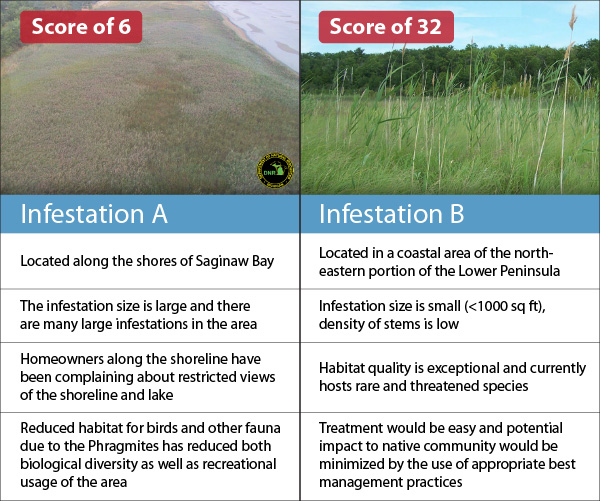By Kevin Walters, Michigan DEQ
August 2013
Updated: September 2014
Background: The Michigan Department of Environmental Quality Water Resources Division has recently developed a new tool to help management groups prioritize the treatment and management of invasive Phragmites in Michigan. While the invasive, non-native variety of Phragmites has become widespread in much of the Great Lakes region, limited funding and resources dictate that groups trying to manage Phragmites regionally should carefully prioritize management sites to improve the likelihood of accomplishing management goals. The prioritization tool will allow those groups to rank many sites and focus on the highest priority locations first. The intended audience of the tool is broad, but includes local, regional and state land managers who may have limited funding and resources and may need guidance for determining which Phragmites populations to target within their management areas. While there are some aspects of the tool that may be useful for individual land owners, the tool is really focused on management at a larger scale which requires careful consideration of both the resources of an organization as well as site-specific requirements.
The new Phragmites tool uses three categories of criteria – ecological, human values, and feasibility/coordination of treatment – as factors to score and ultimately prioritize invasive Phragmites infestations for management. The ecological criteria include considerations such as the region of Michigan where the infestation is located and the quality of habitat in the surrounding area. The human values criteria consider such things as property ownership, severity of aesthetic impacts, and whether the infestation is causing a human safety hazard. Finally, the feasibility and coordination criteria include the difficulty of the treatment at a specific location and whether nearby Phragmites treatment is planned.
Smaller infestations (less than 1000 square feet) are assigned the most points while the fewest points are assigned to infestations with difficult treatment and/or access and infestations with additional Phragmites very abundant in nearby locations (50% of similar habitat within about 2 miles is also infested). Each individual criterion is scored according to the answers given and then the total score can be used to rank and prioritize multiple treatments. To help visualize how the tool works, think about two Phragmites infestations being considered for treatment:
Conclusion: This tool aids with structured decision making in the face of a complex ecological issue. While the tool is specific to Michigan, we hope that it can help inform decision making across the region by encouraging managers to carefully consider multiple criteria and weighing the relative importance of each criteria prior to making management decisions.
We hope that you will use this tool and provide feedback! We are always looking to improve and welcome any constructive comments.
A user guide is also available that gives more details about how to use the tool and describes the criteria used for prioritization in detail. The Phragmites prioritization tool and user guide can both be found online here.
For more information about this tool, contact:
Kevin Walters – Aquatic Biologist
MI DEQ Water Resources Division
waltersk3@michigan.gov
517-335-3457

